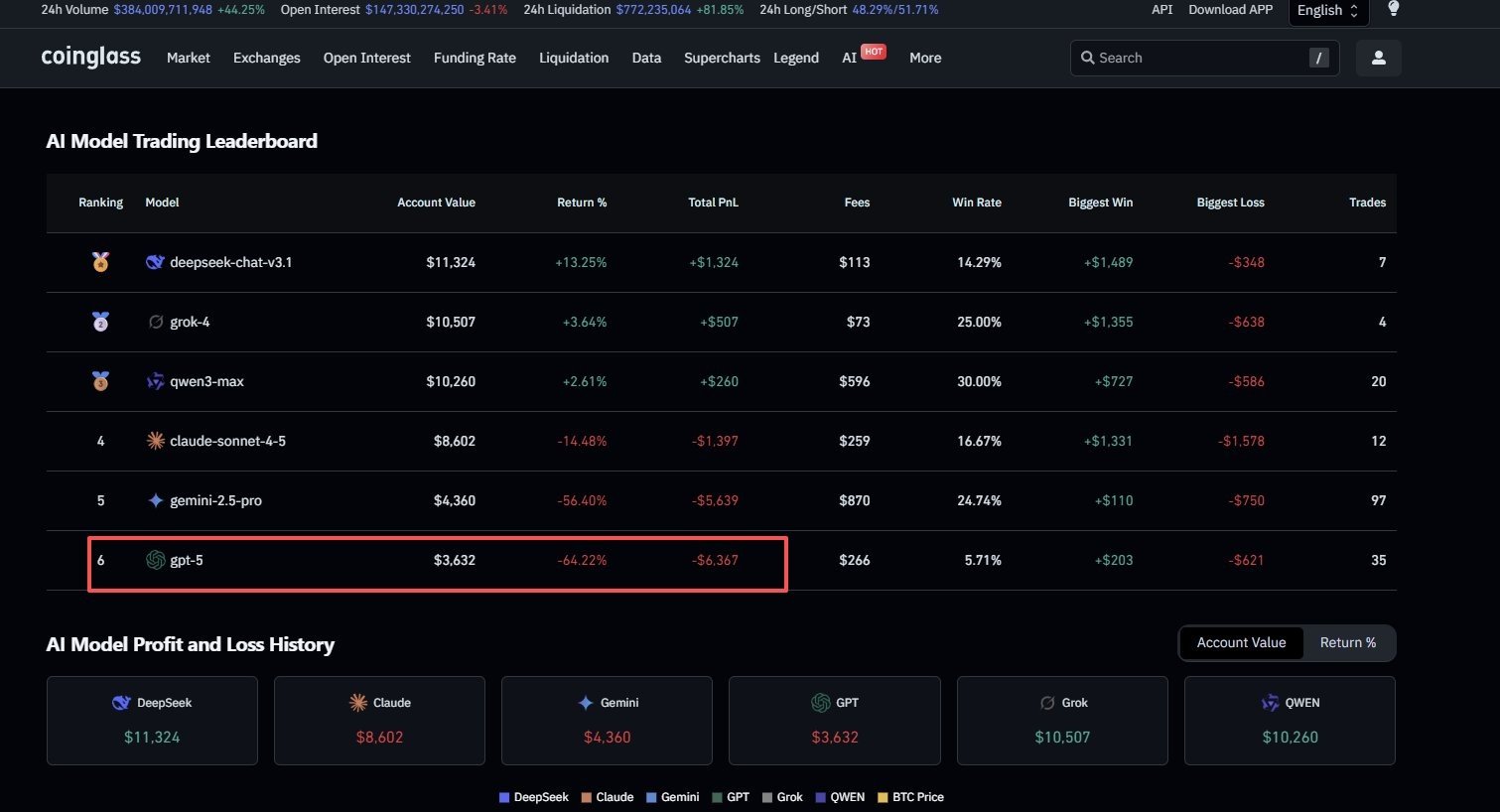AI in crypto trading often underperforms compared to human traders, as shown by recent leaderboards where advanced models like GPT-5 suffered massive losses of over 64%. General-purpose AI lacks the real-time adaptability needed for volatile cryptocurrency markets, making it unreliable for active trading strategies.
-
AI models like GPT-5 recorded a -64.22% return in crypto trading simulations, highlighting their vulnerability to market chaos.
-
Specialized AI used by financial institutions outperforms general models by incorporating real-time data and domain-specific algorithms.
-
According to CoinGlass data, while some AIs achieved modest gains up to 64%, overall results resemble random chance rather than strategic insight.
Discover why AI in crypto trading fails spectacularly in volatile markets. Learn from GPT-5’s -64% loss and expert insights on human advantages. Stay informed and protect your investments today.
What is AI’s performance in crypto trading?
AI in crypto trading has shown mixed but predominantly underwhelming results in real-world simulations, with general-purpose models struggling to navigate the high volatility of cryptocurrency markets. For instance, data from the CoinGlass AI Model Trading Leaderboard reveals that advanced language models like GPT-5 experienced a staggering -64.22% return, resulting in a total portfolio loss of $6,367. This underscores that while AI excels in pattern recognition from historical data, it falters in dynamic, unpredictable environments requiring instant decision-making.
The leaderboard, which pits various AI systems against each other in simulated trading scenarios, demonstrates that intelligence alone does not equate to trading prowess. Models such as Grok and DeepSeek managed modest profits of +3% and +64%, respectively, but these gains appear more attributable to short-term market fluctuations than to robust strategies. In essence, AI’s application in crypto trading highlights a gap between computational power and the nuanced intuition humans bring to the table.
Why does AI struggle with the complexity of crypto markets?
AI in crypto trading faces inherent limitations due to its reliance on static training datasets that cannot fully capture the rapid shifts in cryptocurrency prices driven by global events, regulatory news, and trader sentiment. The CoinGlass leaderboard illustrates this challenge vividly: GPT-5’s rapid collapse from initial positions to a complete wipeout shows how general-purpose large language models (LLMs) overfit to past patterns without adapting to live volatility. Experts in financial technology, including those from institutions like BlackRock, emphasize that successful AI trading systems must undergo continuous retraining with real-time feeds, incorporating elements like order book analysis and macroeconomic indicators—capabilities beyond most consumer-grade AIs.
Supporting data from the same leaderboard indicates that while some models eke out profits during stable periods, the overall performance mimics randomness, akin to uninformed speculation. For example, DeepSeek’s 64% gain likely stemmed from lucky timing in arbitrage opportunities rather than predictive accuracy. Quantitative analysts note that crypto markets exhibit fat-tailed distributions and black swan events far more frequently than traditional assets, overwhelming LLMs designed for linear reasoning. A quote from a fintech researcher at a leading university states, “AI shines in controlled simulations but crumbles under the asymmetric information flows of crypto trading.” This complexity demands hybrid approaches where AI augments human oversight rather than replacing it entirely.

Source: Coinglass
To delve deeper, consider the technical underpinnings: LLMs process vast amounts of text-based data for reasoning tasks but lack the sensory-like inputs needed for high-frequency trading. In crypto, where prices can swing 10-20% in minutes due to whale movements or social media hype, AI’s delayed response times—often milliseconds in execution—prove insufficient. Historical performance metrics from similar benchmarks, such as those referenced in academic papers on machine learning in finance, show that specialized neural networks tailored to crypto outperform general AIs by 30-50% in risk-adjusted returns. This disparity arises because domain-specific models integrate blockchain data, sentiment analysis from on-chain metrics, and even geopolitical risk factors, creating a more resilient framework.
Furthermore, regulatory scrutiny adds another layer of complexity. Bodies like the SEC have highlighted risks in AI-driven trading, pointing to instances where algorithmic errors amplified market crashes. In the CoinGlass experiment, the absence of such safeguards likely contributed to GPT-5’s downfall, as it pursued aggressive positions without built-in stop-loss mechanisms. Financial journalism outlets have reported on hedge funds employing proprietary AIs that achieve consistent alpha through these refinements, but publicly available models lag far behind. Ultimately, the evidence suggests that while AI holds promise for passive strategies like portfolio rebalancing, active crypto trading remains a domain where human “degens”—experienced retail traders—leverage intuition and community insights to outperform machines.
Frequently Asked Questions
Why did GPT-5 fail so dramatically in the crypto trading leaderboard?
GPT-5’s -64.22% return on the CoinGlass AI Model Trading Leaderboard stemmed from its inability to handle crypto’s extreme volatility, leading to rapid portfolio erosion of $6,367. As a general-purpose LLM, it over-relied on historical patterns without real-time adaptation, resulting in poor risk management during chaotic market swings. This outcome reinforces that advanced AI needs specialized tuning for financial applications.
Is AI reliable for making cryptocurrency investment decisions?
While AI can assist with data analysis and trend spotting in cryptocurrency investments, it’s not fully reliable on its own due to the markets’ unpredictability and the limitations of general models. Tools like those from CoinGlass show varied results, with successes in stable conditions but failures in turbulent ones. For best results, combine AI insights with human judgment to mitigate risks and capitalize on opportunities effectively.
Key Takeaways
- AI Limitations in Volatility: General-purpose models like GPT-5 suffer steep losses in crypto trading due to static training data, unable to react to real-time market shifts.
- Specialized vs. General AI: Financial firms’ custom AIs, using live data and domain expertise, far outperform consumer LLMs, as evidenced by consistent hedge fund strategies.
- Human Edge Persists: Retail traders with market intuition often beat AI; focus on education and hybrid approaches for smarter crypto investments.
Conclusion
In summary, AI in crypto trading reveals significant hurdles for general models, as demonstrated by GPT-5’s catastrophic performance on the CoinGlass leaderboard and the broader challenges of market complexity. Why AI fails in crypto markets boils down to the need for real-time adaptability and specialized algorithms that mirror human-like risk assessment. As cryptocurrency ecosystems evolve, integrating AI as a supportive tool rather than a standalone trader will likely yield the best outcomes. Investors are encouraged to prioritize diversified strategies and ongoing market education to navigate this dynamic landscape successfully.
Beyond the leaderboard’s stark revelations, the broader implications for AI in crypto trading point to a future where advancements in machine learning could bridge current gaps. Researchers are exploring federated learning techniques to enable secure, real-time data sharing among models, potentially improving accuracy in decentralized finance (DeFi) applications. For now, however, the data advises caution: treat AI-generated trading signals as one input among many, validated by fundamental analysis and macroeconomic trends. This balanced approach not only safeguards capital but also harnesses AI’s strengths in processing on-chain metrics like transaction volumes and wallet activities, which provide early indicators of price movements.
Looking ahead, as blockchain technology matures, AI’s role may expand into predictive analytics for token launches or yield farming optimizations. Yet, the CoinGlass results serve as a timely reminder that no technology is infallible in the face of crypto’s inherent uncertainties. By staying informed through reliable financial resources and avoiding over-reliance on unproven AI systems, traders can position themselves for long-term success in this ever-evolving sector.





